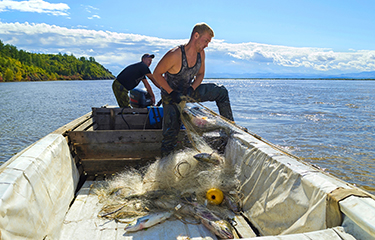Activists push Russia to ban salmon fishing in Amur River amid abysmal returns

The WWF and indigenous peoples of Russia’s Far East are pushing authorities in the country to ban salmon fishing in the Amur River, which a drastic decline in spawning salmon in recent years.
The Amur River, running along Russia’s border with China, is the longest in Russia’s Far East and the tenth-longest river in the world. The river is a spawning ground for salmon stocks in the Sea of Okhotsk and the Japan Sea, and hosts its own salmon fishery targeted by both commercial fishers and indigenous people.
Up until 2014, the Amur River salmon season started in summer and ran through mid-October. But in 2013, flooding harmed spawning grounds and caused a significant decrease in stocks, pushing the season later into the year. Since 2014, the season has begun in late August and run through mid-October.
Since the flooding, salmon returns in the region have been dismal as the population of chum salmon – the main species caught in the river – nosedived. In 2021, the season was one of the worst on record, with a projection of 13,000 metric tons (MT) of salmon – much lower than previous years – proving to be optimistic when harvesters only caught 5,700 MT, leaving many local fishermen jobless and indigenous people without fish used for nutrition throughout the year.
Halfway through the season, in September, the government of the Khabarovsk region banned fishing in the Amur lagoon so salmon could get further upstream, but even that couldn’t avert a crisis, as the government was forced to take emergency measures to provide indigenous people with enough volumes of chum salmon from other sources.
The years of dismal harvests have led environmental activists and some scientists to push for government intervention on fishing in the area, saying that a total ban is needed to allow the species to recover. In late 2021, the WWF called on government bodies at both the federal and regional levels in Russia to impose a complete ban on fishing in the Amur River for at least four years, pending surveys indicating a recovery in stocks. Four years is typically the period of time needed for a chum juvenile to grow to commercial size.
The calls for a ban have gone unheeded. The preliminary harvest projection for the season in 2022 is 7,000 MT.
Following the issuance of the projection, WWF and the Association of Indigenous People of the North of Khabarovsk Region (AIPNKR) held a press conference calling the current situation an “imminent catastrophe.”
“It’s time to admit the truth and stop deceiving themselves,” WWF Amur Green Belt Program Senior Specialist Olga Cheblukova said. “There is no fish in the spawning grounds. While fishing is conducted in the Amur lagoon and the lower reaches of the river, salmon don’t get to the spawning grounds and to the people living on the shores upstream. These are clear signs of overfishing.”
Mikhail Skopets, a biology scientist and expert on Far Eastern salmon, said the density of chum in the Amur River spawning grounds decreased by 100 times in 2021 compared to 2020. That average density is 5,000 times lower than the density recommended by science, he said.
Russia has faced similar declines in the past, with disastrous results. AIPNKR President Lyubov Odzyal said chum and humpback salmon in the waters of the Sakhalin region also saw huge declines amid overfishing in the recent past. Despite the dire situation, a ban on fishing came too late, and according to Odzyal, the region's salmon fishery hasn’t recovered.
“In 2021, when surveying spawning grounds, we found nothing. There were fishnets, but there were no fish,” she said.
Authorities and fishery scientists for the area met soon after the press conference to discuss a strategy for the Amur River salmon season, but the Russian Federal Agency for Fisheries said following the meeting that no consolidated opinion had been reached on reducing fishing pressure.
Specialists at the Russian Research Institute of Fisheries and Oceanography (VNIRO) proposed the Amur River season run only until mid-September, The Khabarovskiy krai news agency reported, and suggested a ban on certain types of fishing gear and a prohibition on fishing in the Amur lagoon. However, fishing companies objected to the measure. Khabarovsk Region Fisheries Association Head Sergey Ryabchenko said it would negatively affect not only businesses but also residents of the few remote villages in the area that are heavily dependent on the catch of salmon.
VNIRO Director Kirill Kolonchin said that an effective compromise on the salmon stocks still needs to be found – adding that a ban seems “excessive.”
Photo courtesy of Konstantin Baidin/Shutterstock






Share